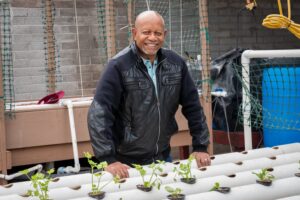More than four decades after Congress enacted legislation to ensure children with special needs are granted the same opportunity for education as those without a disability, parents and school officials still struggle with how those services should look for individual students.
In Laveen and Roosevelt elementary school districts, the number of children who fall under the special education designation is rising with the population growth in Southwest Phoenix. Given Arizona’s poor record for spending money on education, parents and administrators find themselves at odds on how to find the financing necessary to help vulnerable students learn in the federally-mandated “least restrictive environment.”
Laveen resident Bonnie Carroll is the mother an adult daughter and a 7-year-old son with Down syndrome. Her son also is diagnosed with autism and Attention Deficit/Hyperactivity Disorder (ADHD). Carroll recently earned her law degree and has a strong legal understanding of the Individuals with Disabilities Education Act (IDEA) and how that applies to her son and other children with special needs.
Part B of IDEA is the portion of the four-part law that addresses public education. The mission for IDEA is to ensure that children with disabilities get the same opportunity for education as those students without disabilities.
To advocate for her child and to help others in Laveen, Carroll started a Facebook group called Laveen’s Exceptional Parents that includes more than 20 families with at least one special needs child.
Carroll also went to a Laveen school board meeting in May to note her concerns about the education children in Laveen receive if they are in a self-contained classroom. In a paper she prepared, Carroll said children in those placements often do not get to participate in such school activities as talent shows, technology days, some field trips and morning recognition programs. She said that children in self-contained classrooms also are not taught all the subjects other children have access to through placement in regular classrooms.
As of the end of May, Carroll said no one has responded to her concerns. She said her son has had some outstanding teachers and therapists during his time in Laveen, but her view is that district officials must do more to include children of all abilities in all parts of the curriculum.
“There are more and more children with disabilities. The numbers are changing drastically,” Carroll said. “How is the education system ever going to deal with it?”
Carroll goes on to partly answer her own question:
“The school districts have to learn how to teach our children. That’s going to be the reality. It’s not possible to choose to no longer teach a group of kids. Previously they could move them into a self-contained classroom and that is what they did. That’s not going to be acceptable. You can’t not teach a huge population, which is what you have when you take into account all the disabilities.”
The National Center for Education Statistics shows that for the school year 2011-2012 that special education students made up 12.9 percent of the total population of school-age students nationwide. While neither Roosevelt nor Laveen break down the numbers by percentages, district officials acknowledge the growing number of children with disabilities attending their schools.
In Laveen Elementary School District, for example, the number of special education students has doubled over the past 10 years growing to 1,156 (including 118 children with 504 accommodation plans). Roosevelt School District has a slightly higher number with 1,248. Both totals also include the developmental preschool programs with 145 in Laveen and 174 in Roosevelt that serve children ages 3-5.
“We all know that Arizona does not adequately fund special education,” says Todd Liolios, director of student services for Laveen. Liolios has held this job for nine years. “That’s why there was an election (in May on Proposition 123). The federal government doesn’t properly fund special education. The federal funding is only 16 percent of what it should be …. It is atrocious.”
Proposition 123 narrowly passed in late May. It will boost funding for K-12 schools in large part by using the state land trust to help add $3.5 billion over 10 years.
For Carroll, it’s about having input on her child’s education. She has been working closely with her son’s team at Roger’s Ranch Elementary School to craft a plan that allows him to attend mainstream classrooms. While IDEA does not specifically spell out that children with disabilities should go to class with their typical peers, it does say children should be taught in the least restrictive environment possible.
How LRE is decided, though, leaves plenty of room for interpretation. Where children are placed and how the school district provides their education is determined by a cross disciplinary team that includes a child’s parents, teacher, a school psychologist and often a variety of therapists, such as speech, occupational, and physical.
Parents may invite anyone they choose to the meeting to review the Individual Education Plan (IEP) including private specialists from outside the district, advocates or others who can help determine the best course for the child’s education. The IEP is a legal document that teachers, faculty and therapists must follow after the team has agreed on the plan.
“As part of our evaluation system each teacher being evaluated must provide an explanation of how they will be meeting the needs of all learners,” said Jeanne N. Koba, superintendent at Roosevelt. “This includes discussion of students on IEPs and how the teacher plans to meet the students’ needs during the lesson that will be (pre-conference) and or has been (post conference) met in the particular lesson.”
Koba said the MET/IEP team looks at each individual child’s needs to determine what the child needs both academically as well as socially in order to progress and grow. “We have several different types of self-contained classrooms, with the goal always being to help children move to a less restrictive/higher functioning class and or general education.”
Both Koba and Liolios said funding and staffing are the two biggest challenges districts face in providing all students with the services they need.
“I would say that funding and finding qualified teachers and other service providers are our biggest challenges,” Koba said. “It is very costly to provide a full spectrum of services and the service providers to go along with the programs. It can be difficult to find the staff, which is highly qualified both on paper and in their actual practice.”
Liolios agreed, saying that special education departments throughout the valley and state struggle with a shortage of qualified employees, which leads to the use of substitute teachers and expensive, contracted staff in some districts.
“Despite the chronic shortage of special education teachers and therapists, each year we have been fully staffed in special education,” Liolios said of his district. “We have been able to do this by providing strong support and structure to our staff. Each new hire is provided with explicit orientation and specialized training. Additionally, each new hire is assigned an expert mentor who works with them throughout the year.”
He estimates an 85 percent district retention rate for special education staff in Laveen.
Brooke Lange, a former teacher in the Laveen district, said funding plays a big part in how well districts can address the needs of individual students. Lange returned to teaching in her native Oregon last year, a state that spent $9,543 per pupil in fiscal 2013 compared with $7,208 for Arizona. The information is from the U.S. Census and was released in May 2015.
She said that her current district emphasizes inclusion of special needs children in a multitude of ways.
“Something my current school district does to support inclusion is having goal meetings where we set social and behavior goals with the students and have them a part of tracking their goals,” said Lange, who previously taught fourth grade at Desert Meadows. “This helps motivate them and strengthens their self-esteem.”
“We call it a “check-in/check-out” system. They check in every morning with the counselors and SPED (special education) team, go over their already set goals, have a positive interaction and then head to their gen-ed rooms.”
Lange said throughout the day the classroom teachers help the children keep score on their goals. “Help is always one walkie-talkie call away if we need push-in support to get a kiddo back on track,” she said. “Having a student leave the room and miss instruction is what we try to avoid. “
At the end of the day the special needs students take their charts back to the check in/ check out team and total up their points. “They get to earn things for reaching their goals and if they don’t reach their goal, they have someone to talk to about what went wrong. It is an amazing system,” Lange said.
While having more money to hire better staff will always be a goal, the local educators also are focusing on innovative ways to integrate students and train general education teachers on how to best support the special needs students in their classrooms.
Despite budget and staff challenges, Liolios said Laveen’s special education program has received the highest rating for seven consecutive years when evaluated annually by the state of Arizona.
“We have worked to creatively maximize our dollars to provide the greatest support,” he said. “First, our generous Laveen voters are very supportive of our mission to educate our students. They have supported elections to provide support for staff salaries and benefits. They have also supported capital elections to fund classroom technology, wheelchair buses and other expenses.”
Liolios said another solution to funding challenges is seeking grants. Laveen said he received word at the end of the 2015-16 school year to that Laveen would receive a little under $10,000 in grant money for use in technology to support special education student achievement. The exact amount hadn’t been determined at press time.
A third solution that Liolios mentioned was paring with outside resources in the community. He said Laveen partnered with Southwest Behavioral and Health Services allowing two behavioral therapists to support students while their salaries are paid by Southwest.
In the Roosevelt district, Koba has a long history working with special education children. She joined the district in 1985, taught special education for 15 year and was assistant superintendent of special Education for approximately nine years.
As superintendent, Koba ensures that Roosevelt offers extensive professional development opportunities to both special education and general education teachers on a wide variety of topics that relate to special education.
“Whenever we see a pattern or trend in questions, needs etc., we attempt to develop training to support the teachers. One of our professional development coaches was selected for the position specifically due to their background and experience teaching special needs students,” she said.
The district also has two consulting teachers who are available to mentor, guide, answer questions and generally support teachers who have special needs students in the general education.
Carroll said innovative partnerships with parents and the local community is one way that Laveen can achieve more inclusion for special needs students. She is working with her son’s school and IEP team to find more ways for him to be part of the mainstream at his school.
“I am working on a model for my son, but it could be a model for other children as well,” Carroll said. “It’s about educating them in an environment where you get them to be a part of society. They need to learn how to be part of society.”
“I think as parents we can help,” Carroll said. “We know all kinds of resources, we know about the research. We could create a plan — one that doesn’t require money, but requires time and dedication.”
By Rose Hutchinson Tring (This article first appeared in the print edition of the South Mountain District News on June 1, 2016)



